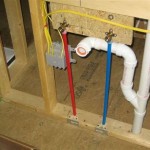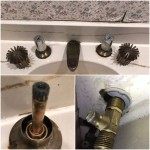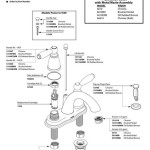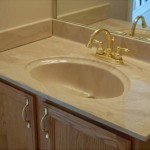How to Treat Black Mold in a Bathroom Ceiling
Black mold, also known as Stachybotrys chartarum, is a type of fungus that thrives in damp and humid environments. It is commonly found in bathrooms, especially on ceilings, due to the constant presence of moisture from showers and baths. Black mold can cause a variety of health problems, including respiratory issues, allergies, and skin irritation, making it crucial to treat it promptly and effectively.
This article will provide a comprehensive guide on how to treat black mold in a bathroom ceiling. It will cover the essential steps for removing existing mold and preventing its recurrence. Remember that working with mold can be hazardous, so it’s essential to take necessary precautions and wear protective gear.
Step 1: Assess the Mold Infestation
The first step is to assess the extent of the mold infestation. This involves visually inspecting the ceiling for signs of black mold growth. Look for dark, fuzzy patches or spots, particularly in areas near the shower or bathtub. If the mold growth is extensive or covers a significant portion of the ceiling, it is recommended to contact a professional mold removal service.
However, if the mold infestation is relatively small, you can attempt to treat it yourself. Once you have identified the affected area, you need to determine the source of moisture that is contributing to the mold growth. This could be a leaking pipe, inadequate ventilation, or condensation buildup.
Step 2: Prepare the Work Area
Before starting the mold removal process, it is essential to prepare the work area to ensure your safety and prevent the spread of mold spores. This involves taking the following steps:
- Clear the area: Remove any furniture, personal belongings, or other items from the bathroom to prevent them from being contaminated with mold spores.
- Protect yourself: Wear protective gear, including a respirator mask, gloves, and goggles, to protect yourself from inhaling or coming into contact with mold spores.
- Cover surrounding areas: Cover surrounding surfaces, such as walls and floors, with plastic sheeting to prevent the spread of mold spores during the removal process.
- Ventilate the area: Open windows and doors to improve ventilation and remove excess moisture from the air.
Step 3: Remove the Mold
Once the work area is prepared, you can begin the mold removal process. This involves:**
- Scraping the mold: Use a scraper or putty knife to remove the visible mold growth from the ceiling. Be careful not to damage the ceiling material during this process. Dispose of the scraped material in a sealed plastic bag.
- Cleaning the area: After removing the visible mold, clean the affected area with a solution of bleach and water. Use a ratio of 1 part bleach to 10 parts water. Apply the solution to the ceiling using a spray bottle or sponge. Allow the solution to sit for 10 minutes before wiping it away with a clean cloth.
- Drying the area: After cleaning, ensure the ceiling is thoroughly dried. Use a fan or dehumidifier to assist with drying. The area must be completely dry before proceeding with the next steps.
Step 4: Address the Moisture Source
After removing the mold, it is crucial to address the underlying source of moisture to prevent its recurrence. This could involve fixing leaking pipes, improving ventilation, or installing a dehumidifier. If the source of moisture cannot be corrected, the mold is likely to return.
Consider these methods to improve ventilation and reduce moisture:
- Install an exhaust fan: Ensure the bathroom has an exhaust fan that is properly vented to the outside. Run the fan for at least 15 minutes after each shower or bath to remove excess moisture.
- Open windows: Open a window or door after showering or bathing to allow fresh air to circulate and remove moisture.
- Use a dehumidifier: Consider using a dehumidifier to remove excess moisture from the air, particularly in humid climates or during periods of high humidity.
Step 5: Seal the Ceiling
Once the area is completely dry and the moisture source has been addressed, you can seal the ceiling to prevent future mold growth. This involves:**
- Applying a sealant: Apply a mold-resistant sealant to the affected area of the ceiling. This will create a barrier that prevents mold from growing again.
- Painting the ceiling: Once the sealant is dry, you can paint the ceiling with a mold-resistant paint. This will help to create a clean and finished appearance.
Step 6: Monitor for Mold Growth
After treating the mold growth, it is essential to monitor the bathroom ceiling regularly for any signs of recurrence. Look for dark patches, fuzzy spots, or a musty smell. If you notice any signs of mold growth, repeat the removal process and take steps to address the moisture source.
Remember, black mold can be a health hazard, so it is crucial to address it promptly and effectively to prevent potential health problems. By following the steps outlined in this article and taking necessary precautions, you can treat black mold in your bathroom ceiling and prevent its recurrence.

Ceiling Mold Growth Learn The Cause And How To Prevent It Environix

Bathroom Ceiling Mold Removal When To Clean Call Branch Environmental

Mold On Bathroom Ceiling How To Clean Off

Black Spots On The Bathroom Ceiling Flood Water Damage Honolulu Oahu Hawaii Md Restoration

How To Remove Black Mold From A Bathroom Ceiling

Mold On Bathroom Ceiling How To Clean Off

Black Mould Removal The Right Way

My Bathroom Ceiling Has Black Mould Growing On It What Should I Do

How To Get Rid Of Mold On Your Bathroom Ceiling Aqa

Ceiling Mold Growth Learn The Cause And How To Prevent It Environix
Related Posts







